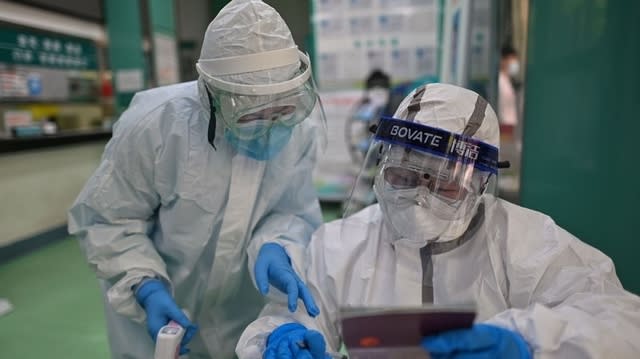2020年9月2日(Wed.) COVID19の長い戦いは続いていますが、新たな情報も伝えられています。(ニュースソース: RTE 9月1日発 )
<原文の一部>
New evidence of airborne coronavirus spread - study
コロナウィルスの空気感染に関する新たな証拠が示されています。研究発表によります。

Technicians assess swabs in a lab in Wuhan, China
*
A person on a poorly ventilated Chinese bus infected nearly two dozen other passengers with coronavirus even though many were not sitting close by, according to a study published today.
Researchers say the findings offer fresh evidence the disease can spread in the air.
Health authorities had initially discounted the possibility that simply breathing could send infectious micro-droplets into the air, but did a U-turn as experts piled on pressure and evidence mounted.
The article published in JAMA Internal Medicine probes the threat of airborne infection by taking a close look at passengers who made a 50-minute trip to a Buddhist event in the eastern Chinese city of Ningbo aboard two buses in January before face masks became routine against the virus.
Researchers believe a passenger, whose gender was not identified, was likely patient zero because the person had been in contact with people from Wuhan, the city where the contagion emerged late last year.
The scientists managed to map out where the other passengers sat, and also test them for the virus, with 23 of 68 passengers subsequently confirmed as infected on the same bus.
What is notable is that the sickness infected people in the front and back of the bus, outside the perimeter of 1-2 metres (three-six feet) that authorities and experts say infectious droplets can travel.
On top of that, the sick passenger was not yet showing symptoms of the disease, such as a cough, when the group made their trip to a religious event.
Researchers also noted the air conditioning simply recirculated the air inside the bus, which likely contributed to spreading of the virus.
"The investigations suggest that, in closed environments with air recirculation, SARS-CoV-2 is a highly transmissible pathogen," they wrote, referring to the name of the virus.
"Our finding of potential airborne transmission has important public health significance."
Their study, which includes a diagram showing where each infected passenger sat, adds to the evidence of airborne transmission, including research into how the virus spread between diners' tables at a restaurant in the southern Chinese city of Guangzhou.
(超抜粋: 注釈のみ)今年の1月、中国での事例を紹介しています。二十数人が乗った換気の悪いバスが、武漢から寧波に向けて50分の移動をしました。この時点ではマスク着用等が始まる以前のことでした。また、座席の間隔等はかなり広かったと考えられ、それでもCOVID19の感染者が出ることになってしまったのです。このことにより“空気感染“(注: 飛沫感染やエアゾル感染でもない)が原因と考えられると研究者が発表しています。(注: 原文を流し読みして下さい。)
***
日本国内に於いては、これまでエアゾル感染への注意呼びかけが少ないように感じています。単純に“三密“を避けましょうとか、手洗い・ウガイ等の励行を促している感があります。しかし、実際は、エアゾル感染もあって、10mぐらい離れていても感染する例もあるし、今回の“空気感染“もあり得るとの報道は、例えば、列車内やエレベータ内等での感染も可能性は低いのかも知れませんがあり得ることと認識すべき情報ではないでしょうか。
*
ところで、本日の東京での感染者数が141人であると速報されました。早く一桁台ぐらいに抑え込んで欲しいものです。
*** 下の写真は、記事内容とは関係ありません。
***










